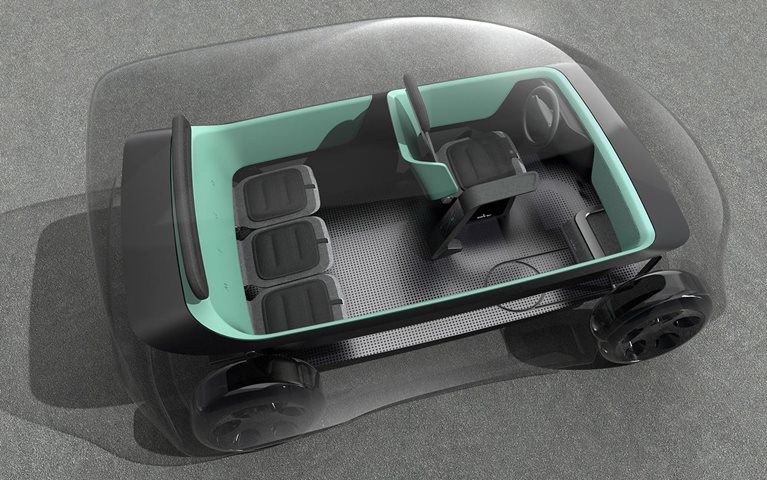It’s 2030, and fully autonomous transportation is real. Driverless rideshares are a fact of daily life, and cars are more like moving super computers than, well, cars. This is the not-so-distant future according to the McKinsey Center for Future Mobility, our think tank helping business leaders and policy makers navigate the changing mobility landscape.
That reality will be a radical departure from everything we love and hate about getting around today, and designers, engineers, mechanics, and executives across the mobility industry are eager to get ready. To better understand what users will want, the center has partnered with the Fraunhofer Institute for Industrial Engineering to create the Mobility Experience and Technology (MXT) Lab in Stuttgart, Germany.

“This is a space for anyone—from suppliers and manufacturers to entertainment providers and insurance companies—to collaborate and test new mobility experience ideas together,” says Timo Moller, a McKinsey partner and Center for Future Mobility leader. “The ecosystem of mobility players is expanding, and our goal here is to bring them together across industries to create new concepts.”
But bringing people together is only part of the lab’s mission. Getting ready for the future of mobility also requires access to the best technology and customer insights, according to Tobias Schneiderbauer, a McKinsey engagement manager and co-leader at the Center for Future Mobility. The lab, he says, provides members across various industries with access to rapid prototype development, online survey design, and simulation technology. “That’s how we’ll arrive at new business models and innovation processes,” Tobias adds.
The interior of tomorrow’s vehicles is a particular focus for the lab. “No longer will external factors, like horsepower, be as relevant when fewer people are owning cars or even driving them,” explains Katharina Petricevic, a McKinsey senior associate. “Plus, increased connectivity to the internet will have users interacting with vehicles in a whole new way.” This introduces opportunities for new onboard services and products, like geo-based promotions that appear across the dashboard when people ride by a retailer’s store.

The lab also helps users consider the rider’s experience. Without having to drive or navigate, every person would effectively become a passenger.
McKinsey studies reveal that 70 percent of riders would use the time for leisure activities, like watching a movie, reading, or shopping online. Michele Bertoncello, a McKinsey partner in our Automotive & Assembly Practice, says that these mobile data-based services can present a revenue potential of over $200 billion USD. “And the ubiquity of mobile devices makes the potential of seizing this opportunity possible,” he adds.
Riders might also use the time for personal enrichment and professional development. Our research has shown that more customers are looking to be productive while traveling in an autonomous vehicle. For example, one potential in-car activity surfaced within the lab is in-car language learning, which presents another area of opportunity for software and app developers.
For designers, developers, or R&D specialists who use the lab, thinking about consumers early on in their research is key. Rather than formulating ideas through instinct or intuition, the lab gives them a chance to ensure new designs are grounded in rigorous research and analysis through demos.

To study how in-car language learning would work, for instance, MXT Lab users conducted live tests with a cockpit mockup to refine results and gather immediate reactions. “We built a pretend prototype—or ‘pretotype,’” says Dr. Florian Hermann, the division director of mobility and innovation systems at Fraunhofer IAO, “which enabled us to simulate and test new kinds of equipment or applications, like augmented reality windshields or AI-based assistant services.”
The language-learning pretotype had simulated features like light-source adjustments, vehicle- and road-noise settings, ride feel, and a movable display across the windshield. While a moderator was reading a story to participants, support personnel could adjust features in the vehicle and measure their impact.
Experiments like this help researchers gather data that complements survey feedback. For instance, a feature containing optimized temperatures and a breeze of fresh air to support learning concentration generated 90 percent positive ratings in an online survey versus a 100 percent positive rating from those exposed to experiments with it.
The MXT Lab convenes different players that may not come together otherwise.
Timo MollerMcKinsey partner and MCFM leader
Such information is critical for evaluating the true market potential of an idea. “We call this the ‘do-or-don’t’ point,” Michele says. “If it can create value, it’s a go.” For the in-car language learning application, the lab gauged consumers’ willingness to pay for such a service and which price points were most accepted through an online survey.
“These kinds of projects are just the beginning,” says Timo. “The MXT Lab convenes different players that may not come together otherwise. We’re seeing that when they do, they’re in for quite a ride.”
